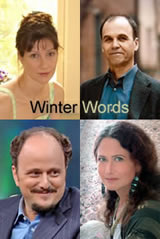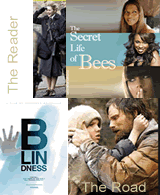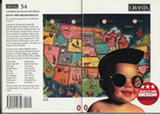John Updike & Rabbit Armstrong
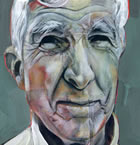 In 1960 when John Updike published the first novel in his Rabbit Agstrom tetralogy, he was 28 years old; Rabitt was 26. Updike wrote a sequel to Rabbit, Run in 1971 called Rabbit Redux, his response to the 1960s; Rabbit reflected much of Updike's confusion and ambivalence towards the social and political upheaval that beset the United States at that time. 1980 saw another sequel, Rabbit is Rich, which won the National Book Award, the National Book Critics Circle Award, and the Pulitzer Prize. The novel found "Rabbit the fat and happy owner of a Toyota dealership".
In 1960 when John Updike published the first novel in his Rabbit Agstrom tetralogy, he was 28 years old; Rabitt was 26. Updike wrote a sequel to Rabbit, Run in 1971 called Rabbit Redux, his response to the 1960s; Rabbit reflected much of Updike's confusion and ambivalence towards the social and political upheaval that beset the United States at that time. 1980 saw another sequel, Rabbit is Rich, which won the National Book Award, the National Book Critics Circle Award, and the Pulitzer Prize. The novel found "Rabbit the fat and happy owner of a Toyota dealership".
In 1990, Updike published the last Rabbit novel, Rabbit at Rest, which saw the death of the poignant character. The novel won the Pulitzer Prize for Fiction and the National Book Critics Circle Award. Updike described Rabbit as "a ticket to the America all around me. What I saw through Rabbit’s eyes was more worth telling than what I saw through my own, though the difference was often slight."Updike later called Rabbit "a brother to me, and a good friend. He opened me up as a writer."




![]()
Ernest Hemingway & Nick Adams
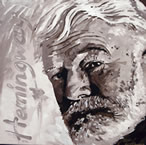 Between 1925 and 1933, Ernest Hemingway published sixteen stories about a character he called Nick Adams. Appearing in various collections and arranged in no particular time sequence, the narratives appeared disconnected and incomplete. In 1972, after Hemingway’s death, the stories were collected, arranged in the chronological order of Adams’ life, and augmented with eight unpublished fragments found after Hemingway’s death. From this reorganization emerged a coherent picture of Nick’s life from his boyhood in upper Michigan through his adult experiences. Nick Adams’ life runs parallel to Hemingway’s life.
Between 1925 and 1933, Ernest Hemingway published sixteen stories about a character he called Nick Adams. Appearing in various collections and arranged in no particular time sequence, the narratives appeared disconnected and incomplete. In 1972, after Hemingway’s death, the stories were collected, arranged in the chronological order of Adams’ life, and augmented with eight unpublished fragments found after Hemingway’s death. From this reorganization emerged a coherent picture of Nick’s life from his boyhood in upper Michigan through his adult experiences. Nick Adams’ life runs parallel to Hemingway’s life.
 Nick Adams is a prototypic Hemingway hero: concerned, reflective, an outwardly impassive soldier and sportsman ravaged in mind and spirit by terrors against which he can mount no defense. He faced evil and futility alone and unaided. Defeat is inevitable and unavoidable; only defeat with dignity offers hope of redemption. From the character of Nick Adams arise the protagonists of Hemingway’s most famous novels. Nick is similar to Jake Barnes in The Sun Also Rises, Robert Jordan in For Whom the Bell Tolls, and Frederic Henry in A Farewell to Arms.
Nick Adams is a prototypic Hemingway hero: concerned, reflective, an outwardly impassive soldier and sportsman ravaged in mind and spirit by terrors against which he can mount no defense. He faced evil and futility alone and unaided. Defeat is inevitable and unavoidable; only defeat with dignity offers hope of redemption. From the character of Nick Adams arise the protagonists of Hemingway’s most famous novels. Nick is similar to Jake Barnes in The Sun Also Rises, Robert Jordan in For Whom the Bell Tolls, and Frederic Henry in A Farewell to Arms.
Philip Roth & Nathan Zuckerman
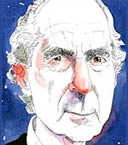 Nathan Zuckerman is a fictional character who has appeared as the narrator or protagonist of many of Roth's works of fiction. Zuckerman makes his first appearance in the novel My Life As a Man, where he is a fictional creation of the writer Tarnopol making Zuckerman, in his original form, an alter-alter-ego. In later books Zuckerman is given a less indentured form of existence, starting with novel The Ghost Writer, where he is the story's writer-apprentice protagonist.
Nathan Zuckerman is a fictional character who has appeared as the narrator or protagonist of many of Roth's works of fiction. Zuckerman makes his first appearance in the novel My Life As a Man, where he is a fictional creation of the writer Tarnopol making Zuckerman, in his original form, an alter-alter-ego. In later books Zuckerman is given a less indentured form of existence, starting with novel The Ghost Writer, where he is the story's writer-apprentice protagonist.
The obvious parallels to Roth's own life as a novelist signaled Roth's burgeoning interest in the relationship between an author and his work. Such meta-fictional concerns would be mined more deeply in Roth's series of 1980s novels, most radically in The Counterlife and Operation Shylock. By the mid-1990s, though, Roth would tamp down on the self-referentiality, and reintroduce Zuckerman as witness and narrator in a trilogy of historical novels: American Pastoral, I Married a Communist , and The Human Stain .
Philip Roth's novel Exit Ghost is the ninth in the Zuckerman series; the author says it will be his last Zuckerman novel. The book, published in October 2007, focuses on Zuckerman as an older man, returning to New York City after an extended period of seclusion in the Berkshires.














 A person with an alter ego is said to lead a
A person with an alter ego is said to lead a
